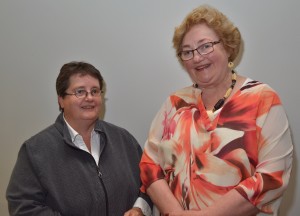
Change keeps Mary-Jo Sullivan on the road these days. Big change.
Sullivan is racking up the kilometres on her car, crisscrossing Wellington and Dufferin counties, and the Region of Waterloo, to talk about the Ontario Trillium Foundation’s new investment strategy.
It’s the thinking behind who and what gets a share of the $110 million Trillium gives every year to eligible organizations and their projects.
“Everything you knew before is out,” Sullivan said May 26 an event Capacity Canada hosted at the Accelerator Centre in Waterloo. “All the old rules are out, and now there are new rules.”
Sullivan is a Trillium program manager for the Waterloo-Wellington-Dufferin area. During an hour-long presentation, and through questions that followed, her message remained rock-steady.
From the time they apply for money through the time they spend it, groups must focus on the impact those grants make. Trillium expects to spend about $1 billion over the next decade, Sullivan said. People want to know what they’re getting for that investment.
“What we haven’t done a good job at is telling the story . . .of how (grants) have made life better in Waterloo-Wellington, and across the province,” Sullivan said.
As it calls on organizations to do more to keep impact front of mind and track results, Trillium is giving something in return.
The application process is clearer, Sullivan said, and the turn-around time to get a cheque in hand will be shorter. The new normal should be 12-14 weeks under most grant categories.
To get there, Trillium has rebuilt the investment strategy, heeding complaints from users of the system, and a review by the Office of the Auditor General in 2011.
The auditor’s report said Trillium needed to do a better job of assessing the worthiness of applications, and monitoring impact after awarding grants.
The new strategy, described in detail on Trillium’s website, lays out six “action areas,” dealing with such things as fighting poverty and getting people to be more physically active.
Self-assessment here, Sullivan said, will help applicants determine whether they fit, or should seek another funder.
From that, there are four grant categories: seed money to start projects; growth money to help them flourish; capital grants to build new structures, as well as replace old ones; and big-project, “collective-impact” grants of up to $500,000 a year over five years.
Process problems in the old system aren’t the only things driving change, Sullivan said in an interview.
“Demand was going through the roof,” she said. “Therefore, we had to figure out priorities where we wanted to invest so we weren’t all over the map.”
The May 26th presentation was Sullivan’s second of the day, and one of 22 she’ll make in the Waterloo-Wellington-Dufferin area. She returns to Kitchener June 8 for a presentation from 3 p.m. to 5 p.m. at the Downtown Community Centre on Weber Street, Kitchener.
There are late-summer and fall deadlines under some grant categories. Meanwhile, groups need to register for eligibility, even if they were listed in the old system.
Registration opens July 22. Groups can start preparing by contacting Trillium’s support centre.
Applicants may have initially thought they were losing something in the new strategy, said Cathy Brothers, Capacity’s chief executive officer, as she thanked Sullivan after the May 26 event.
“I don’t feel that after this presentation,” Brothers said. “I think there are tremendous opportunities here.”

